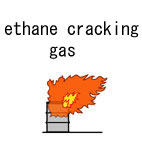| Case Name |
Fire of cracked gas leaked from outlet piping of an ethane cracking furnace at an ethylene manufacturing plant |
| Pictograph |

|
| Date |
May 9, 1985 |
| Place |
Kawasaki, Kanagawa, Japan |
| Location |
Chemical factory |
| Overview |
On May 9th, 1985. A fire occurred on starting an ethane cracking furnace at an ethylene manufacturing plant. About two hours after starting of feeding ethane, high-temperature combustible gas leaked into the air through cracked piping, and ignited. As brick chips were stuffed into the guide sleeve, it was not possible to release thermal expansion of the tube. A crack was generated in the piping, and a rupture occurred. |
| Incident |
A weld of a pipe elbow between an ethane cracking furnace and a quenching boiler at an ethylene manufacturing plant ruptured, cracked gas leaked, and a fire occurred. |
| Processing |
Manufacture |
| Individual Process |
Maintenance |
| Chemical Reaction |
Cracking |
| Substance |
Ethane cracking gas (Mixture of ethane, ethylene, hydrogen etc.) |
| Type of Accident |
Leakage, fire |
| Sequence |
The turnaround shutdown maintenance was conducted at an ethylene plant till March of 1985, and the inside walls of the ethane cracking furnace was repaired. The plant started again at the middle of March.
On May 7th-8th. Decoking of the ethane cracking furnace was performed.
About 14:00. Feeding of raw material ethane started.
About 16:20. Direct Digital Controller (DDC) in the control room showed abnormal temperature at the furnace outlet. The operator went to the field to confirm the state, and found flames coming out of quenching boiler inlet piping.
About 16:25. The fire was extinguished with steam injection. |
| Cause |
The cause of the fire: Cracked gas at 750 °C leaked from the point of a crack in a piping weld. Due to a high temperature, ethane (ignition point 515 °C), ethylene (490 °C), and hydrogen (530 °C), etc. which were the main components, ignited.
The cause of breakage: As brick chips were stuffed into the guide sleeve at the bottom of the furnace, it was not possible to release thermal expansion of the cracking tube. A crack was generated in the piping, and a breakage occurred. |
| Response |
Workers informed the control room about the accident.
A fire was extinguished with spraying steam onto the position of the leak.
An emergency shutdown of the furnace was carried out.
Nitrogen gas was introduced. |
| Countermeasures |
It must be confirmed that there is no blockage in the guide sleeve by removing the cap of the lower guide sleeve at a turnaround shutdown or remodeling. |
| Knowledge Comment |
Brick chips deprived the guide sleeve of the function of thermal expansion absorption, and an accident occurred. Inspection and cleaning of such components are also important.
Although various mechanical countermeasures are taken against high-temperature thermal expansion, the meaning of every countermeasure must be understood, and suitable maintenance for each must be carried out. |
| Background |
The guide sleeve guaranteeing thermal expansion when the temperature becomes high during operation was stuffed with brick chips, which prevented the cracking tube from stretching. The accident was caused due to inadequate management of the components that are small but have important roles. |
| Incidental Discussion |
A large number of the piping components, such as the supports, release and absorb thermal expansion of piping. Although these components look unimportant, they have very important safety roles. |
| Reason for Adding to DB |
Example of fire caused due to leaked gas through a crack generated by thermal expansion |
| Scenario |
| Primary Scenario
|
Poor Value Perception, Poor Safety Awareness, Inadequate Risk Recognition, Organizational Problems, Poor Management, Slackness of Management, Carelessness, Insufficient Understanding, Insufficient Recognition of Risk, Usage, Maintenance/Repair, Insufficient Cleaning, Failure, Fracture/Damage, Crack by Thermal Extension, Secondary Damage, External Damage, Leakage
|
|
| Sources |
High Pressure Gas Safety Inst. of Japan. Major accidents related to High Pressure Gas Control Law in 1985. Present state of high-pressure gas accidents. pp.18-19, 61-62(1986).
High Pressure Gas Safety Inst. of Japan. Ethylene manufacturing plant. Cracked gas leakage and combustion from ethane cracking furnace outlet piping. Accident examples of Petroleum refinery and Petrochemical units. pp. 105-108(1995).
|
| Physical Damage |
Electric wiring for instrumentation and heat insulating material were damaged by fire. About 1.2 kg of cracked gas burned. |
| Multimedia Files |
Fig2.Situation showing figure
|
| Field |
Chemicals and Plants
|
| Author |
DOBASHI, Ritsu (School of Engineering, The University of Tokyo)
TAMURA, Masamitsu (Center for Risk Management and Safety Sciences, Yokohama National University)
|